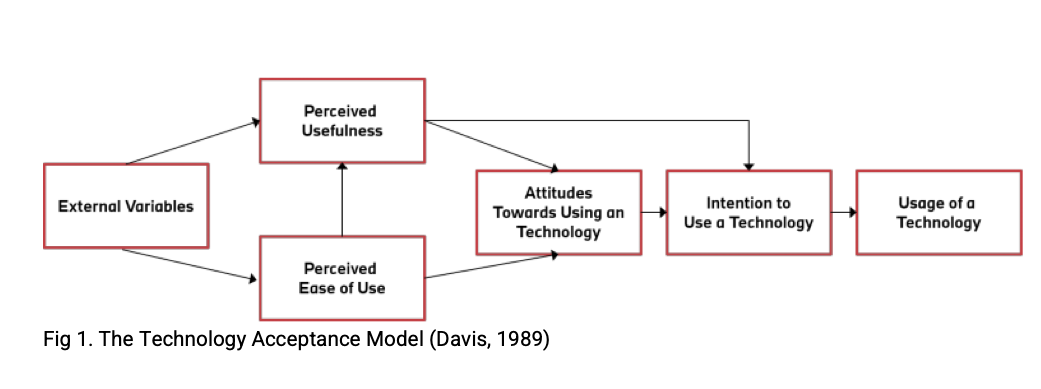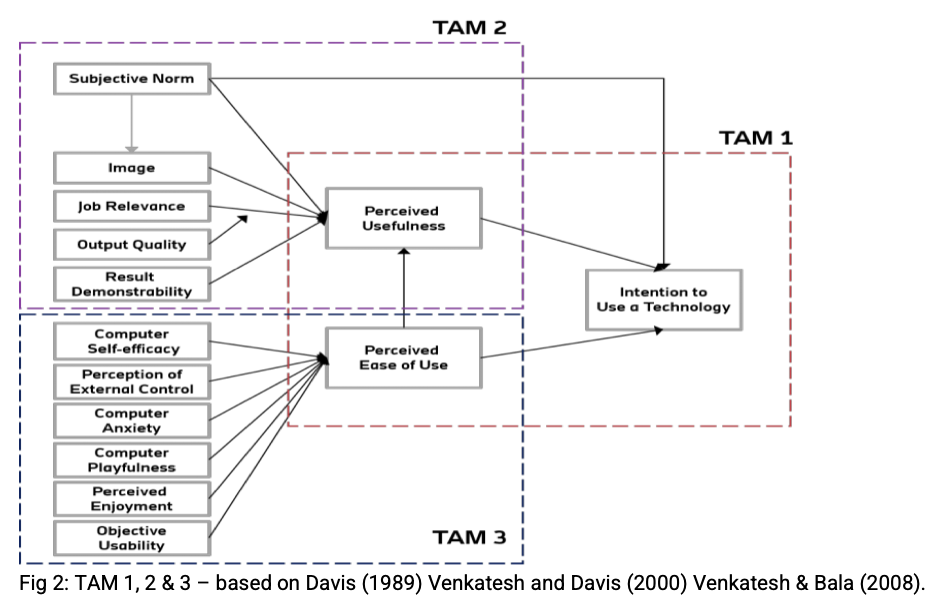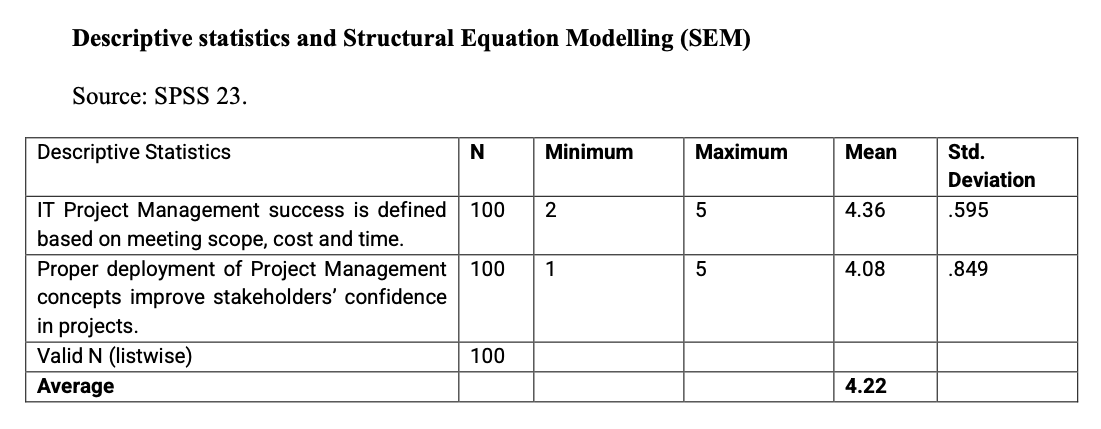
Examining the significance of the Technology Acceptance Model in IT project success. The case study of ABC Bank Gambia
Information Technology Projects are successful in every organization when they are concluded on time, within the specified scope, resources, budget, and have met stakeholder and customer satisfactions. Durmic (2020) stated that success factors of projects can vary from project to project and industry to industry, but the factors considered important for success in any information technology project are the same. The project factors include the project customers, project team, project planning, project execution, project control and project success as model that can be leveraged to achieve a successful project implementation. One of the key indicators of project success is the effective implementation of the project and the project outcome. A new information technology project surfacing cannot positively impact on the effectiveness of an organization if not embraced and utilized by the potential users. This is what informed the Technology Acceptance Model that was developed by Fred Davis in 1989. It addresses two fundamental issues; perceived utility and perceived ease of use of projects undertaken by an organization. The former has to do with the level of belief users have regarding the effectiveness of using a new system or project to improve performance. The latter is the level of conviction users have that the usage of the new project will be more efficient. This idea was first shared by Fishbein and Ajzen (1975) in the Theory of Reasoned Action (TRA). Davis adopted the TRA to specifically address user acceptance of information systems and projects. He posited that both perceived utility and ease of use have a direct effect on behavioural intention of people.

Perceived Usefulness: chronicles the extent to which an individual is convinced that their productivity can increase with the use of a new technology. For instance, if the technology can help to fasten the completion of assigned tasks.
Perceived ease of use: defined as the level of physical or mental attempt at using the new technology introduced in the organization.
TAM 2 and TAM 3
Due to the amount of reproval faced by critics on the model, TAM was broadened to capture other factors such as social impact, age and sex, all of which have an effect on behavioral intents. Particularly, TAM2 is a modification of TAM to accommodate all the social components that impact on the behavior to use or not to use a new system. This modification was done by Venkatesh and Davis in 2000. Further improvement on the model was done eight years later by Venkatesh and Bala in 2008.

When introducing a new technology in an organisation, this model is applied by carrying out a survey on the staff to determine the “perceived usefulness and perceived ease of use” after an initial trial. Results from the survey helps to evaluate the attitude of the staff towards the new technology. Rating of answers is done based on the score for each of the following:

TAM1 has proven not to be difficult to understand, but still retains a high level of conjecture in different contexts. As an improvement on TAM1, TAM2 and 3 incorporates external factors such as social influence into the model. This further enriches the model and makes it farther reaching. Katzenbach and Smith (1993) noted that for the desired success of a project to be achieved, goals must be set and these goals must be “specific, measurable, aggressive, and time-bound (SMART)”. These are the items that embodies the project management concepts of project initiation, project planning, project execution, project monitoring, and project closeout as outlined by the Project Management Institute.
Research Objective:
The nature of information technology projects could be attributed to low success rates of project deployments. Daniels and LaMarsh, (2007) added more factors to include shortage of skilled staff members, too many application constraint both known and unknown, poor requirement definition and even constant change in technologies to be used. When projects fail has always been a worry to project stakeholders especially the project managers and hence the ever increasing need to ensure that projects are delivered successfully to meet stakeholders’ expectations. This study aimed to examine the role of Technology Acceptance Model in project success. To that effect, a descriptive survey was undertaken using good project management practices as the basis for “perceived usefulness and perceived ease of use”.
Literature Review
Al-Mamary, et al. (2015) Investigated the key factors influencing on management information systems adoption among telecommunication companies in Yemen. They discovered that for ICT projects in Yemen to be successful, adequate support from the top management of an organization was needed through timely financing, purvey of needed resources, and strict adherence to the goals and objectives of the organization. On the part of the project team, they equally acknowledged that proper motivation and synergy are vital in enhancing the success of the project. The staff in Yemeni telecommunication industry need to develop their proficiency to enhance their capacity to successfully achieve set targets. As noted by Brynjolfsson & Hitt (2008), industries embrace latest technologies when they are optimistic of its ability to attract efficiency, flexibility and improve the quality of a product. Many organizations sink funds into technology to ameliorate organizational performance and attain competitive advantage. As a result, technologies are evolved to achieve specific needs of business and project. It is in this regard that Linderoth (2010) acknowledged that the project team is a crucial part of a social grid. When an organization decides to embark on a new project, the processes and mode of execution are not always the same for each project because each has its unique features different from other. Therefore, it is required for the workers to adjust and get used to the new processes to fit in accordingly. This transitioning does not always go smoothly for some of the project team members. According to Zwikael and Unger-Aviram (2010), to develop a good team is not a simple task, but to have one is a very important step towards an improved level of performance and increased productivity. Many corporate organizations today have adopted a strategy of arranging trainings within the organization and outside, holding workshops, arranging seminars and conferences to equip, develop and strengthen workers for the greater good of the organization. Companies that adopt these growth and development strategies are the most appropriate for building teams that are motivated and willing to give their best towards the success of the companies (Linzalone, 2008). As argued by Huemann (2010), creating innovative ways to work as a team through these strategies is a fantastic way to strengthen workers’ ebullience and encourage team participation which will positively impact on effectiveness and efficiency among members of the team for the greater good of the organization
Data Analysis and Discussion of Results
The article made use of primary data obtained through questionnaire from ABC Bank Gambia for analysis.
Table 2
Descriptive statistics and Structural Equation Modelling (SEM)
Source: SPSS 23.

Table 2 show that the majority of the respondents represented by an average mean of [M=4.22] agreed that project management success is largely impacted by good management practices. IT Project Management success is defined based on meeting scope, cost and time [M=4.36, SD=0.595], and Proper deployment of Project Management concepts improve stakeholders’ confidence in projects [M=4.08, SD=0.849].
Structural Equation Modelling (SEM) Assessment
The Structural Equation Modelling (SEM) Amos help to depict the level of influence of good project management practices on project success. According to Hair et al (2010), Tucker and Lewis (1973), and Bentler (1990), the model is deemed appropriate and accepted if the Goodness of Fit (GFI) is greater than 0.90, the value of the CMIN/df is greater than 2 and less than 5, the Tucker and Lewis Index (TLI) and the confirmatory fit index (CFI) are greater than 0.90, the AMOS computed value of the standardized Root Mean Square Residuals (RMR) is less than 0.08, and the Root Mean Square Error Appromixation (RMSEA) is less than 0.08.
Source: SPSS Amos 23.

In this study, the estimated structural equation model was used to test the impact of good information technology project management practices (PMP) on Information technology project success in ABC Bank. The fit indices for the model as shown in Table 2 depicts that, the goodness of fit (GFI) is less than 0.90 at 0.45, the CMIN/df is less than 5 at 4.42, the standardized Root Mean Square Residuals (RMR) is less than 0.08 at 0.03, and the Root Mean Square Error Appromixation (RMSEA) is less than 0.08 at 0.02. However, the Tucker and Lewis index (TLI) and the confirmatory fit index (CFI) are both less than 0.90 at 0.00 each. Overall, the author concludes that the model has a good fit. The result further showed that the influence of project management practices on project management success is significant as the P value (***) is less than .001, the C.R (21.322) is by far greater than 1.96. The regression estimate is also .872 which means that an 87% variance in project success is accounted for by good project management practices embedded in project management concepts used by ABC Bank in its information technology projects. The result of this model is a confirmation that Information Technology project success is largely impacted by good project management practices. This is consistent with the Technology Acceptance Model (TAM1,2 &3) because the success of a project begins with acceptance of the project both by the project team in charge of the project execution and the end users. It is this acceptance that results to good project management practices.
Conclusion
The results from the survey affirmed that project management success is largely impacted by good project management practices were found to be true. SPSS Amos was used to check the relationship between good information technology project management practices and project management success. The result proved that good Information Technology Projects Management practices indeed have a positive and significant relationship with project success.
Bibliography
Al-Mamary, Y., Shamsuddin A., & Aziati, N. (2015). Investigating the key factors influencing on management information systems adoption among telecommunication companies in Yemen: The conceptual framework development: a review. International Journal of Energy, Information and Communications.
Daniels, C. B. & LaMarsh, W. J. (2007). “Complexity as a Cause of Failure in Information Technology Project Management,” 2007 IEEE International Conference on System of Systems Engineering, 2007, 1-7, doi: 10.1109/SYSOSE.2007.4304225. https://ieeexplore.ieee.org/stamp/stamp.jsp?tp=&arnumber=4304225
Durmic, N. (2020). Factors Influencing Project Success: A Qualitative Research. TEM Journal,9(3),1011–1020. https://web.p.ebscohost.com/ehost/pdfviewer/pdfviewer?vid=0&sid=93fd058b-8a2d-43d1-9a0d-1a886f795cfa%40redis
Hair, J. F., Black, W. C., Babin, B. J. et al. (2010). Multivariate Data Analysis (7th ed.). Upper Saddle River, NJ: Pearson Prentice Hall.
Huemann, M. (2010). Considering human resource management when developing a project-oriented company: Case study of a telecommunication company. International Journal of Project Management, 28(4), 361-369. doi:10.1016/j.i jproman.2010.02.008.
Linderoth, H. (2010). Understanding adoption and use of BIM as the creation of actor networks. Automation in construction, 19(1), 66-72.
Linzalone, R. (2008). Levearaging of knowledge asset to improve new product development performance. Measuring business excellence,12(2), 33-39.
Katzenbach, J. R., & Smith, D. K. (1993). The discipline of teams. Harvard Business Review, 71(2), 111-120. Retrieved from Business Source Complete database. (AN 17602399)
Zwikael, O., & Unger-Aviram, E. (2010). HRM in project groups: The effect of project duration on team development effectiveness. International Journal of Project Management, 28(1), 413-421. doi:10.1016/j.ijproman.2009.09.005
Author: Lucky Osime Aigbokhaebho, student LIGS University
Approved by: Bibiana Batovska, lecturer LIGS University



